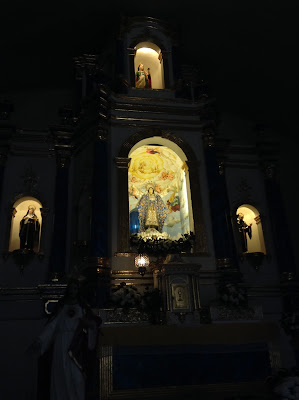Here’s another town that is
famous in Laguna, it is known for making fine wood crafts and beautiful
craftsmanship. The town of “Paete”, which is normally pronounced by us
southerners, those living near the said town as “payte”, but it is pronounced
as “Pa-e- te”, for it to have a meaning, because it is derive from “Paet”,
wherein it means the act of carving, “nag pa paet”.
 |
| Paete town as viewed at the Tatlong Krus viewing deck |
Since they are famous for wood
carving, they have a festival in line with it, the Paet- taka festival which is
held in September if I’m not mistaken.
What’s good with Paete?
Paete is one bus away from Manila
and a jeepney ride from Santa Cruz.
It is relatively a small town,
and could tour the whole town less than a day. Let me start with the church, it
is dedicated to Saint James the Great Apostle, but before that, the town’s
patron is Saint Christopher.
There are two paintings of this
saint located near the entrance, an original version of it, which depicts Saint
Christopher with Jesus in a coconut tree, and the other one is the Filipino
version, which shows Saint Christopher crossing the river together with Jesus
sitting at his shoulder, (photos of the painting were taken from google).
 |
| Paete Church (credits to: google) |
The town follows thew Spanish grid system wherein the town hall, plaza and the church is at the center of the poblacion.
As for the paintings of Saint
Christopher, the townspeople covered it with something, in order for it not to
be destroyed by the Japanese.
The church is relatively small,
but it could house a lot of carrozas during Holy week because of their
tradition of having an exit at the main portal of the church, before proceeding
procession.
The altar mayor of Paete Church, this was taken last Holy Thursday 2016, as you can see it is a tradition among churches to cover the images in their altar with violet cloth to signify their sorrow. Located in the center niche of the altar mayor is San Santiago Mayor Apostol, the image is being clothed with embroidered vestments, sorry if I do not have picture of their patron saint.
He is somehow not depicted riding a horse, instead he is holding a stick and a bible.
As for other tourists spots, one
can hike Mount Humarap. The mountain is also famous for another name, which is
Tatlong Krus. Well, this site will once again be flocked by pilgrims to have
some penitence for the upcoming Holy week.
To start with, Tatlong Krus, is a
long hike, it is not that steep because of the staircases that were put up, for
pilgrims to have easier access up to the mountain, but it surely will make you
tired. It’s a long hike, but you can stop once in a while.
Here are the photos on our way up, at the peak of the mountain, and going down from the mountain:
Here are the photos on our way up, at the peak of the mountain, and going down from the mountain:
Well, once you reach the peak,
you will be able to see the small town of Paete, and you may somehow imagine,
that the town may be small but it is rich with culture. Despite the issues it
faced in the past regarding illegal logging for their wood carvings.
Pictures of us on the way down.
You will also cross a stream wherein you will walk over bamboo stalks, this stream is part of the Talon Falls somewhere at the middle part of the mountain.Pictures of us on the way down.
What makes me sad is that their
religion isn’t only one, the town is also influenced by the religion Aglipay.
Nevethless, both dominant relgion promotes faith to God.
One may also eat at Femma's pizza house, their famous food is pizza- spaghetti, or explore the small town itself, I suggest that you go visit the town during holy week.
photos used are all mine, except for the picture of the Saint Christopher painting, and the facade of Paete church.
photos used are all mine, except for the picture of the Saint Christopher painting, and the facade of Paete church.















































